Sambousek is a bite-sized half-moon-shaped fried meat pie served as part of the Lebanese mezze. In this recipe, you will learn how to make the pastry dough and the meat filling without any fancy equipment!
Please dedicate a few hours to make a batch of these meat pockets and don't forget to freeze some before frying!
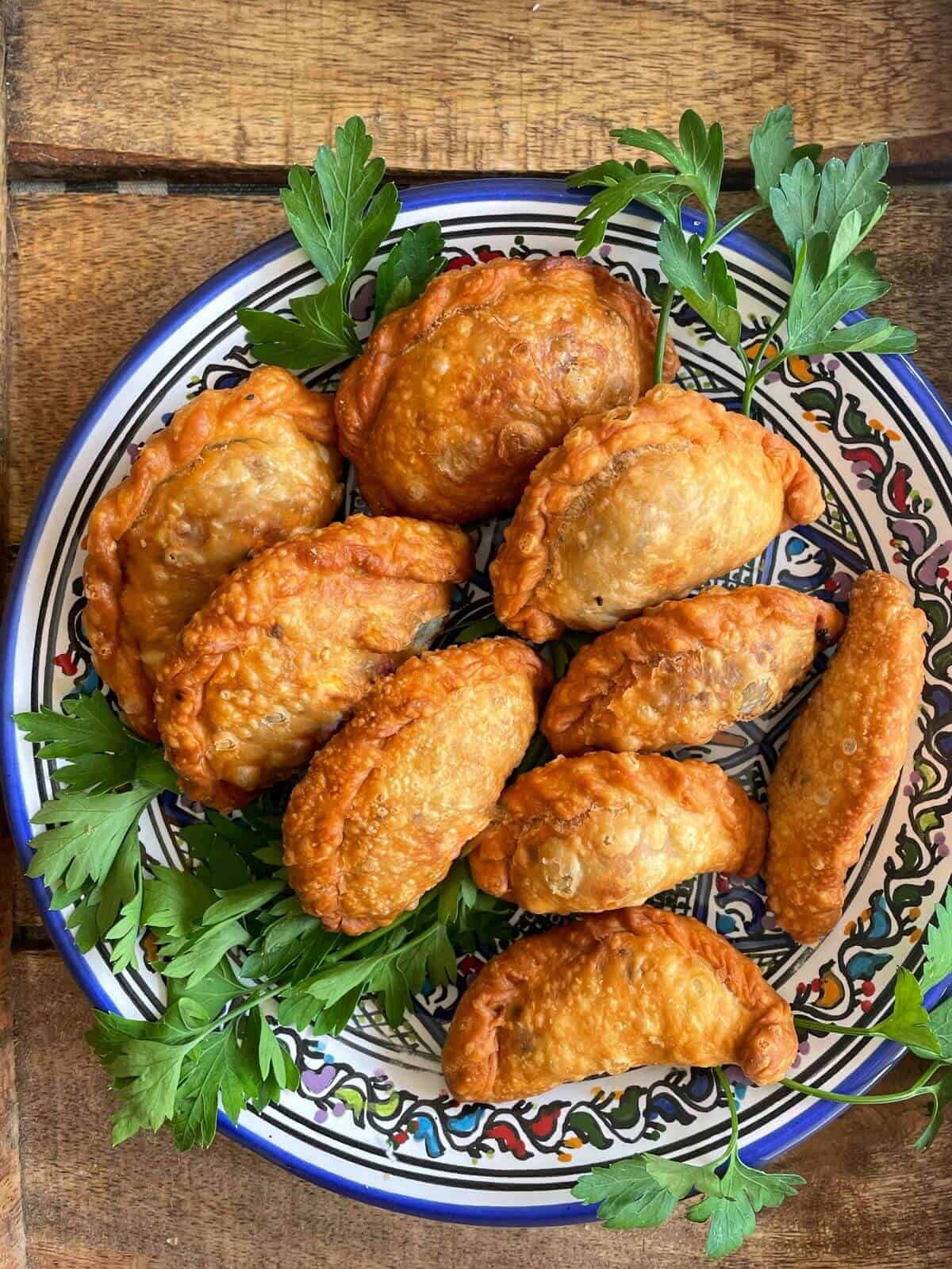
Sambousek, Middle eastern turnovers are a must-have Ramadan Iftar treat and are best when deep-fried but they can also be baked.
Though I have quite a few samosa recipes on the blog like this Lebanese chicken sambousek, Saudi moong bean sambosa, Kerala erachi samosa, or Afghan sambosa they all use store-bought samosa leaves or puff-pastry.
In today's sambousek recipe, I have shared how to make the dough for sambousek and a simple Lebanese recipe for beef pastry with pine nuts filling.
Jump to:
Ingredients
- olive oil (used in dough and filling)
- pine nuts
- onion
- ground beef
- ground spices: cinnamon, allspice, salt and pepper
- pomegranate molasses
- salt and pepper
- fresh parsley(optional)
- flour
- salt
- olive oil
- water
- cooking oil (used for frying)
See recipe card for quantities.
How to make it?
You can either start with the dough or with the filling— totally as per your schedule. The filling can be made a day ahead and refrigerated. The dough needs to be rested for an hour.
I like to start with the filling and let it cool while I prepare the pastry dough.
For substitution options, please scroll down.
sambousek beef filling
time taken: approx 15 minutes
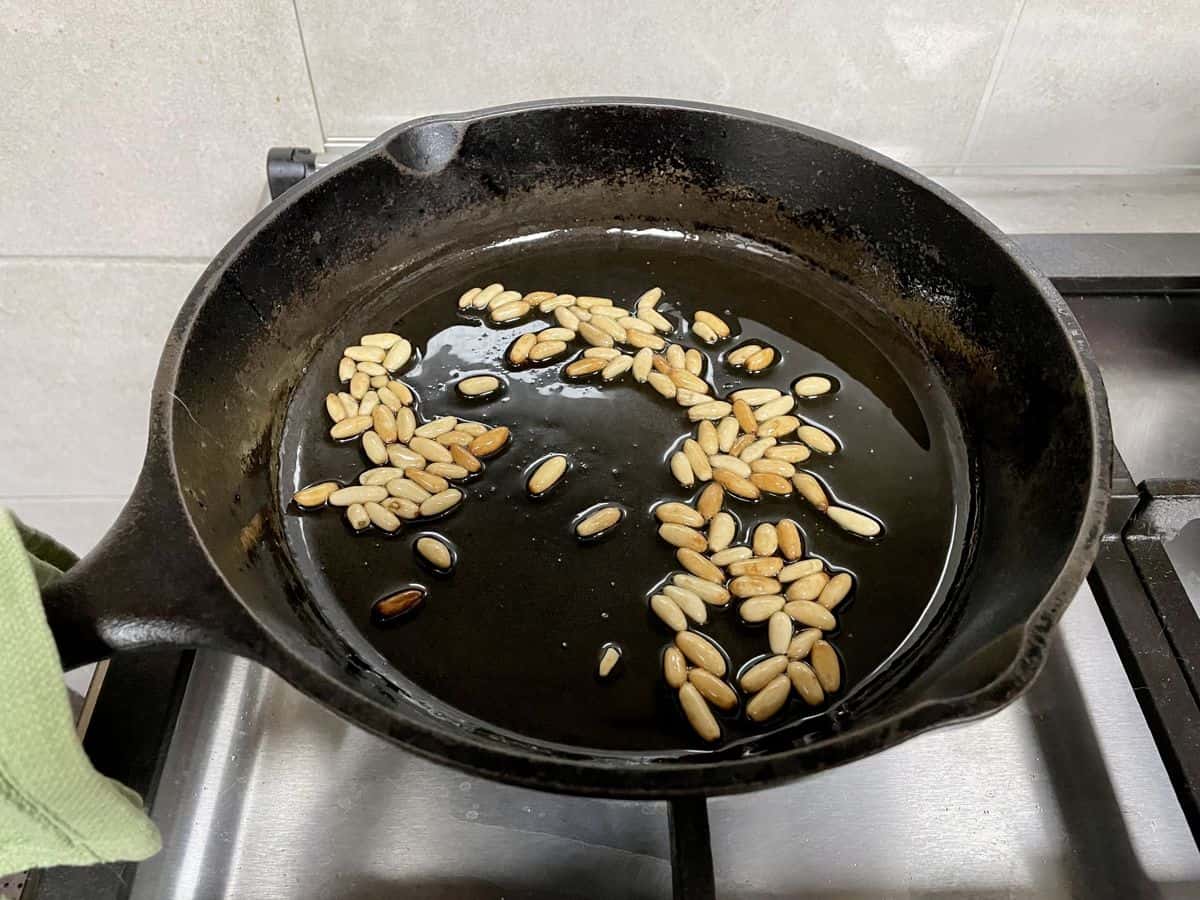
Heat olive oil in a thick-bottomed skillet and fry the pine nuts until golden brown. Remove using a slotted spoon and keep them aside.
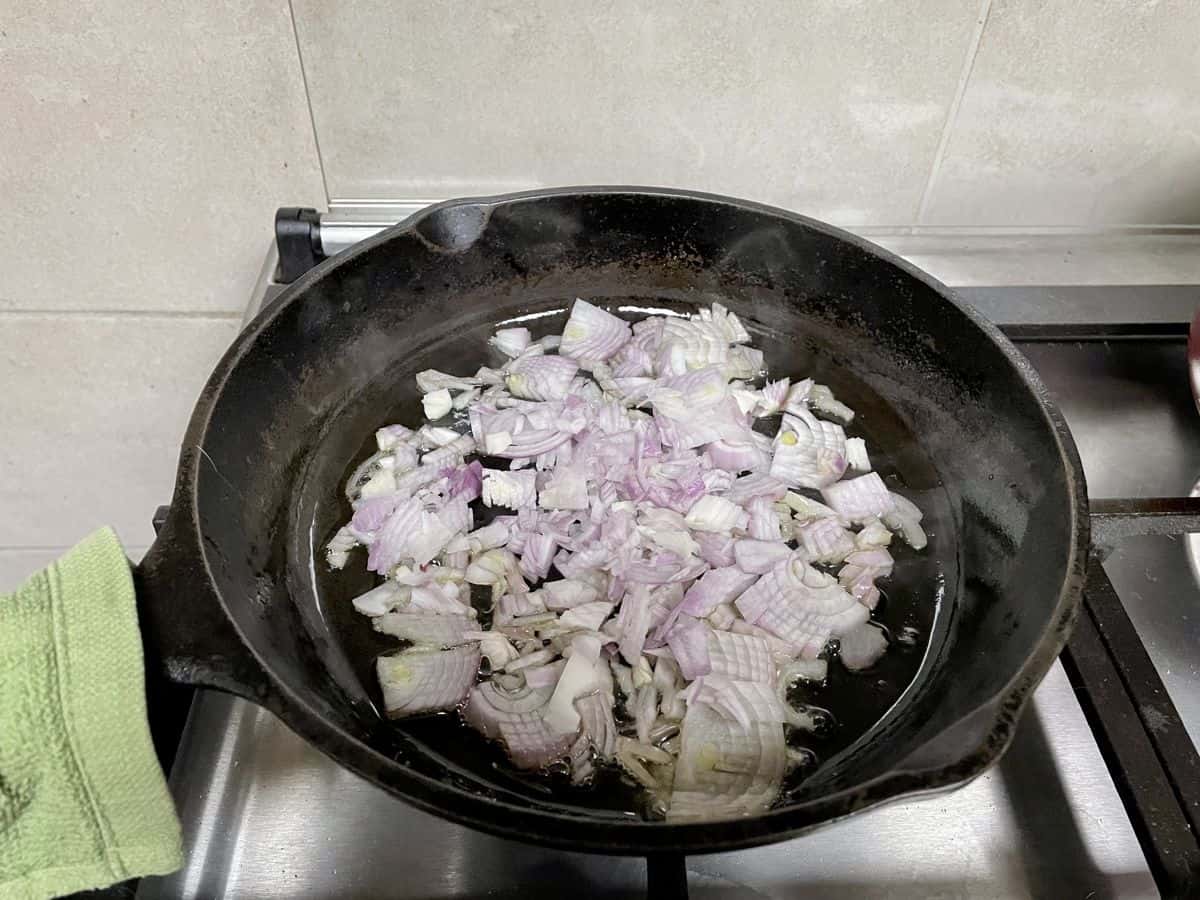
Add the finely chopped onions.
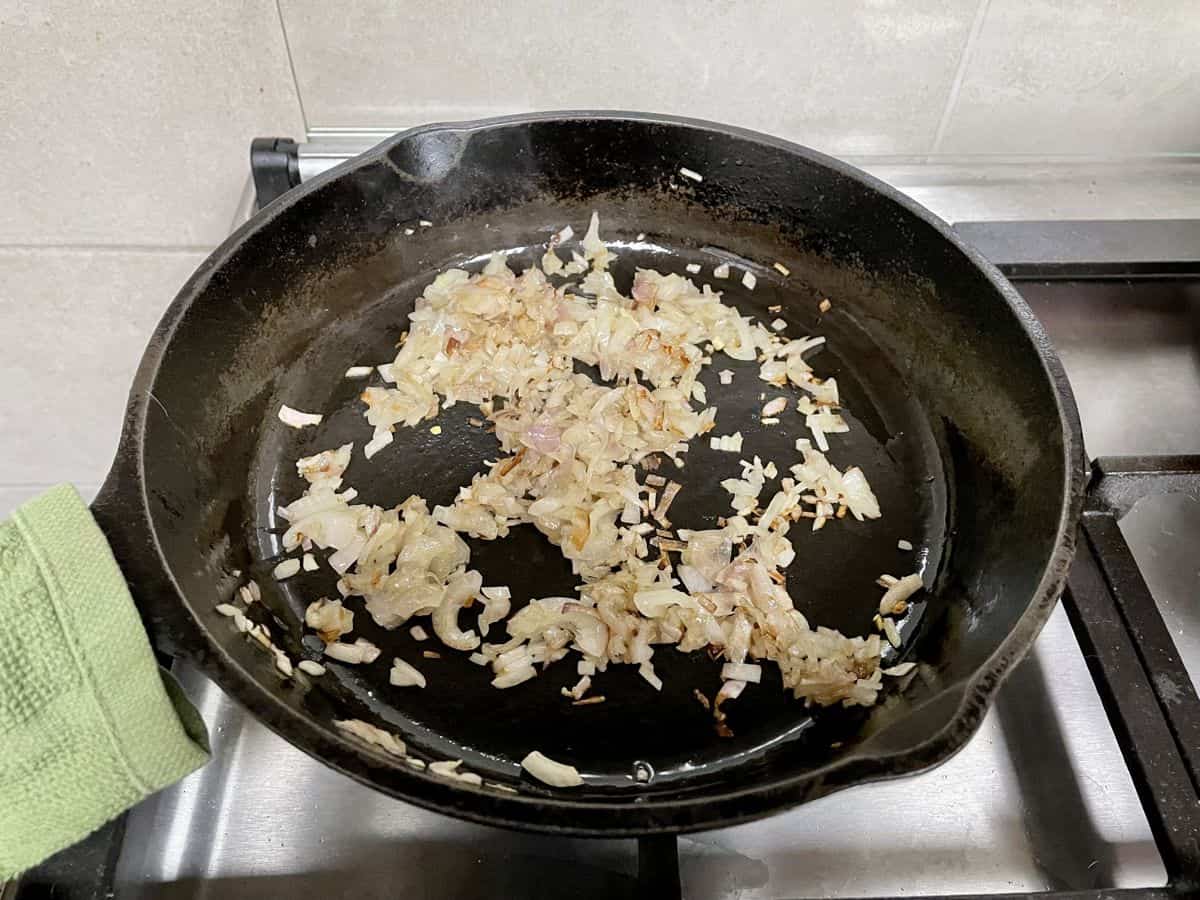
Fry the onions for a few minutes until they start to brown.
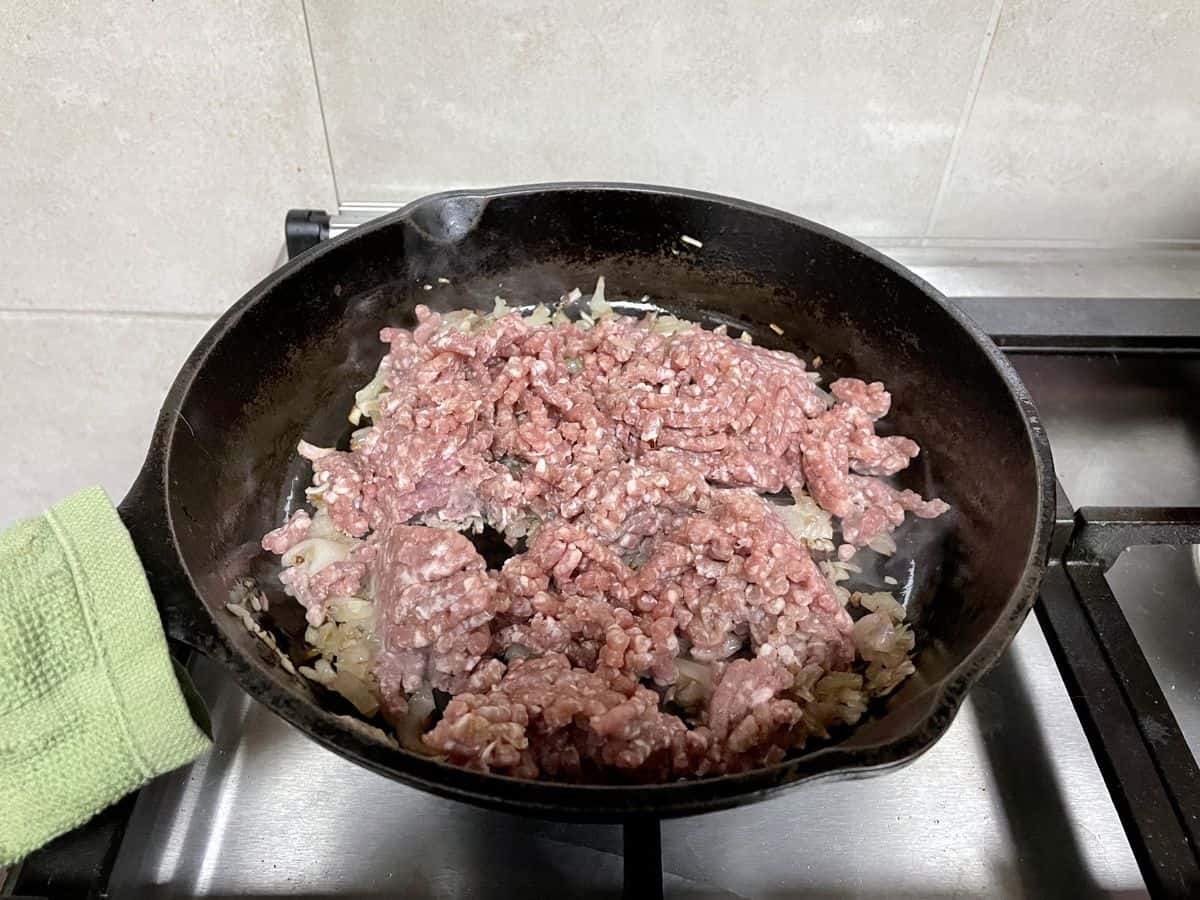
Next, add ground meat – beef or lamb and fry with the onion until every bit is browned.
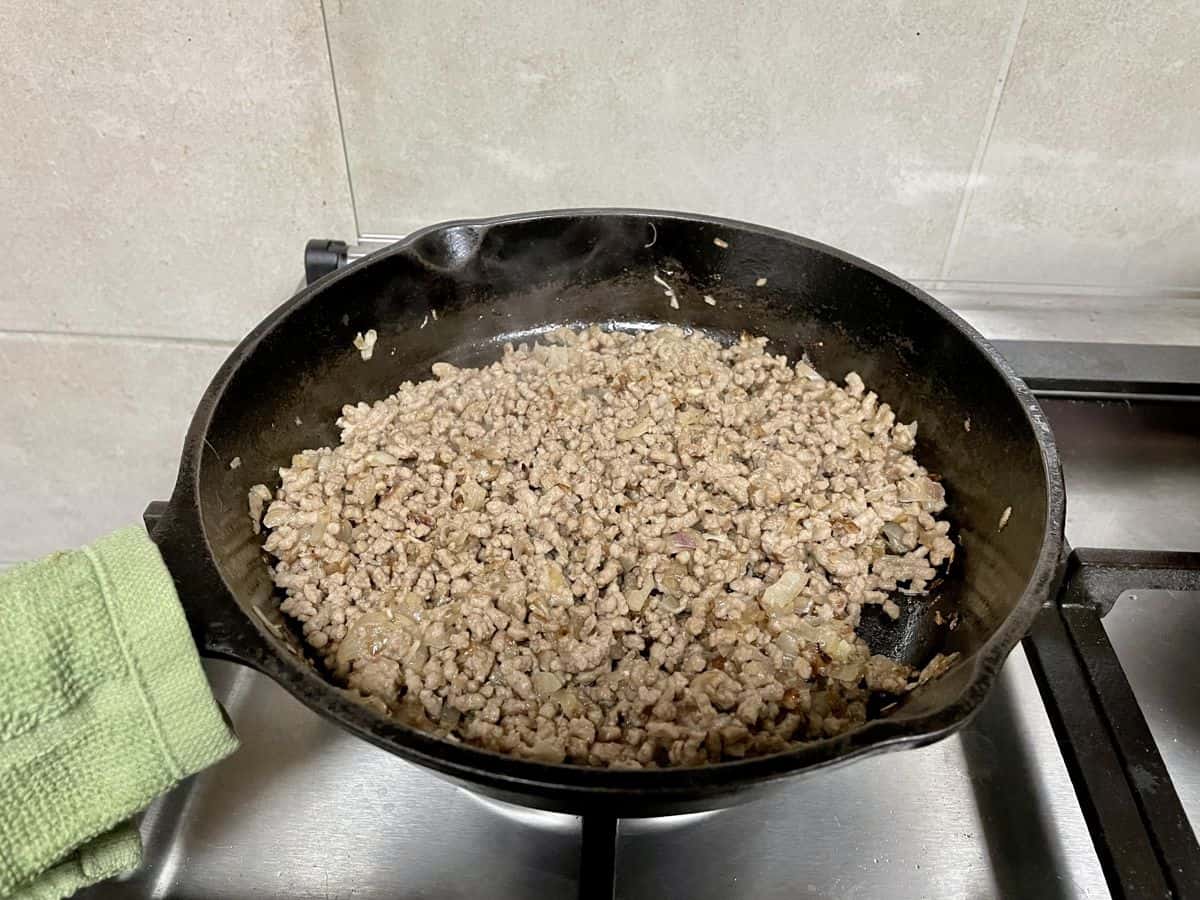
The meat will release moisture, so continue to fry until dry.
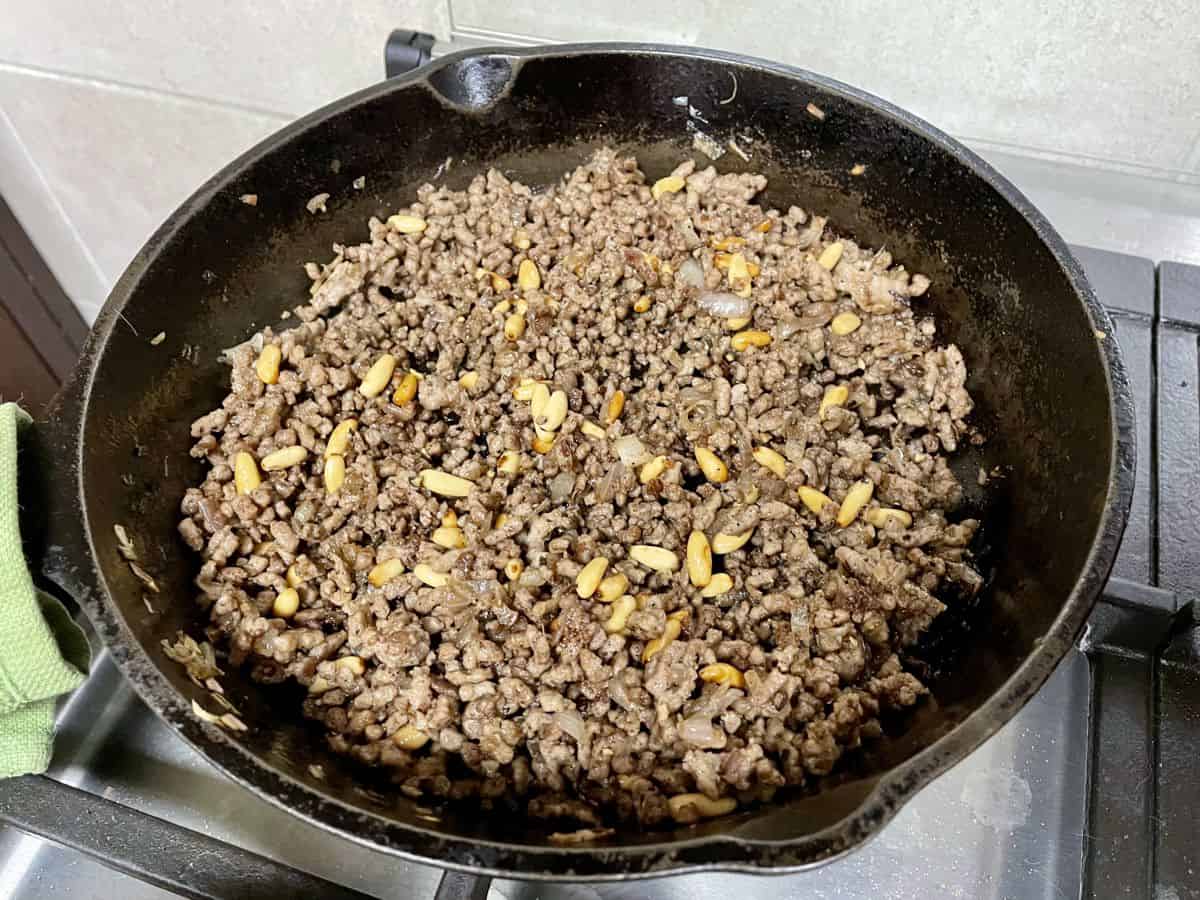
Stir in the pomegranate molasses, ground spices, salt and pepper as per taste. Saute until mixed through and aromatic. Switch off and stir in the fried pine nuts. Transfer the content to a bowl and let it cool before using it.
Sambousek dough
time taken: approx 25 minutes
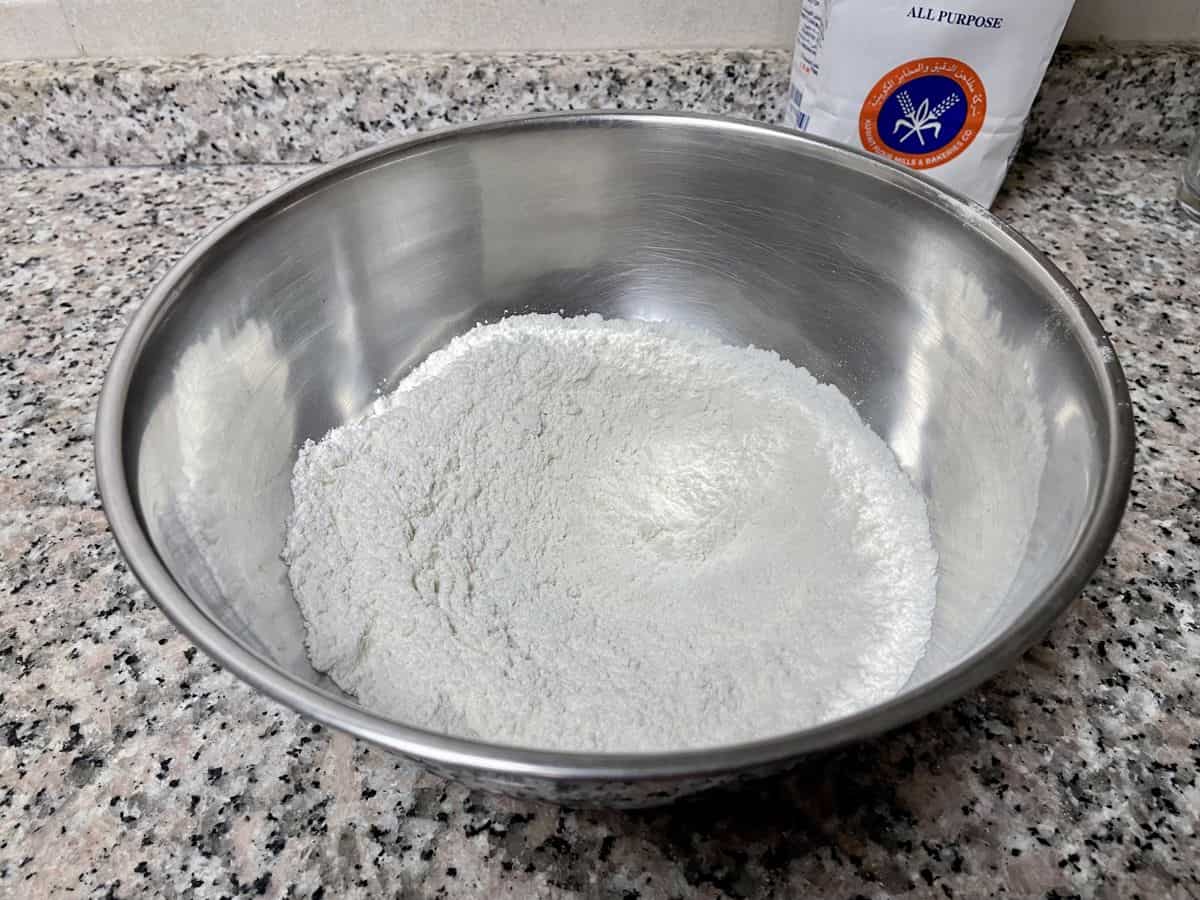
Add the flour and salt to a large mixing bowl and stir it.
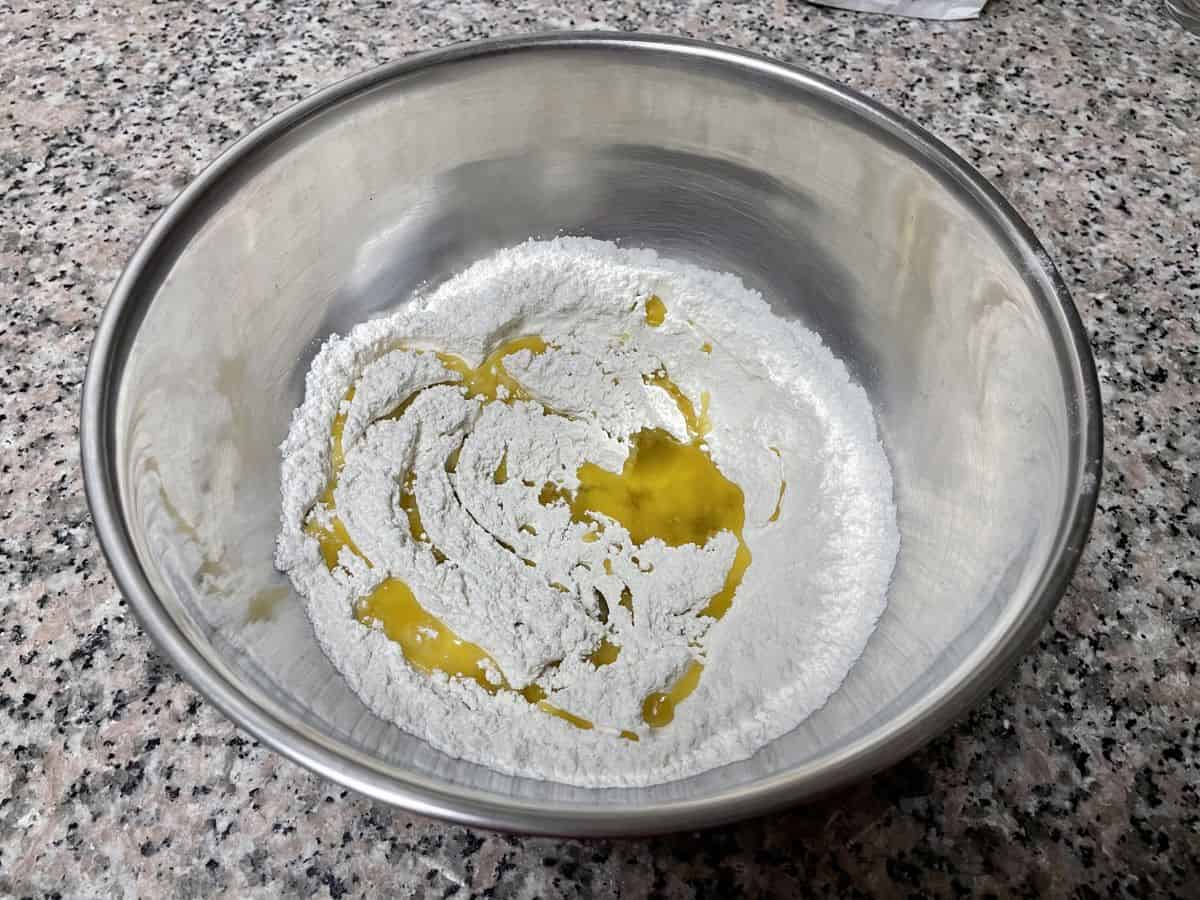
Drizzle the olive oil all over the flour.
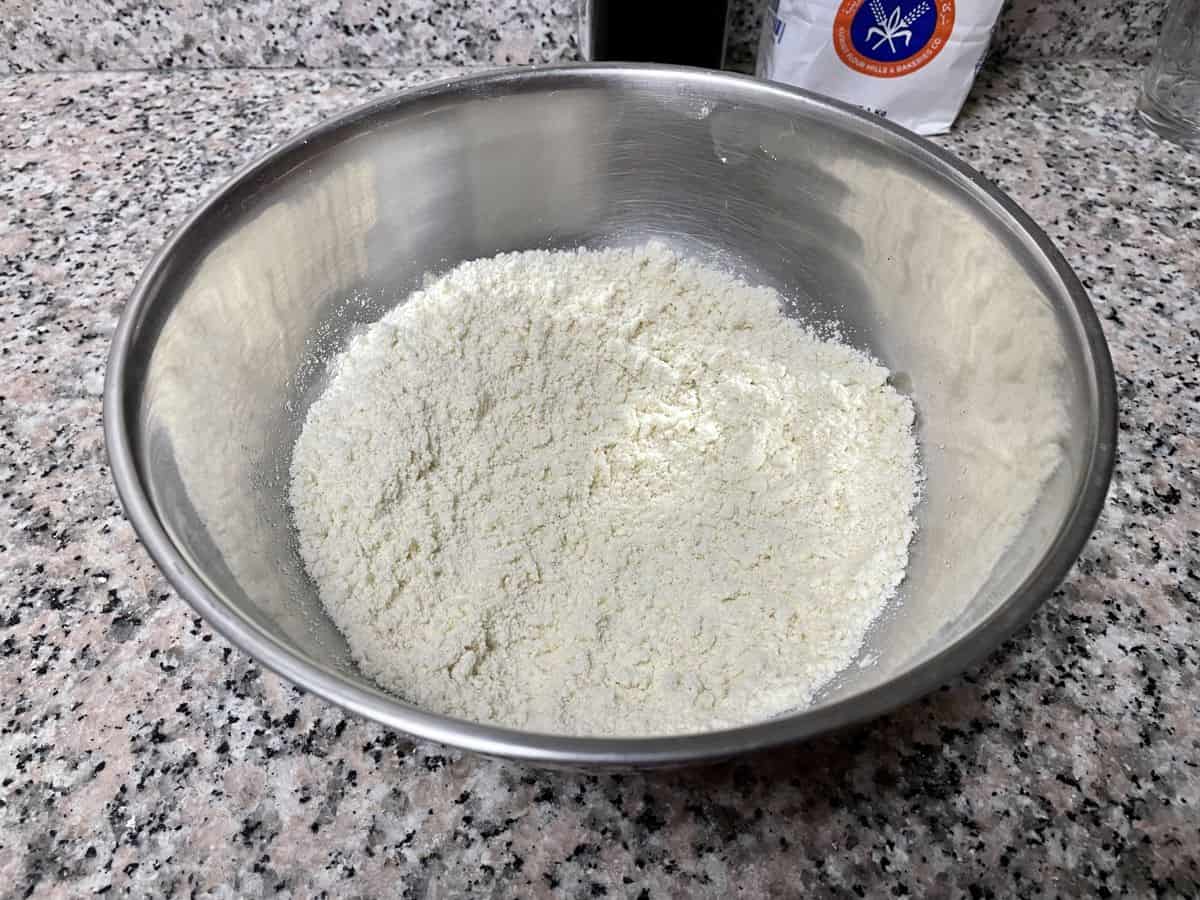
Take time to gradually rub the oil and flour between your palms until the flour resembles a grainy texture. When you grab some flour in your fist, it should hold shape but also break easily.
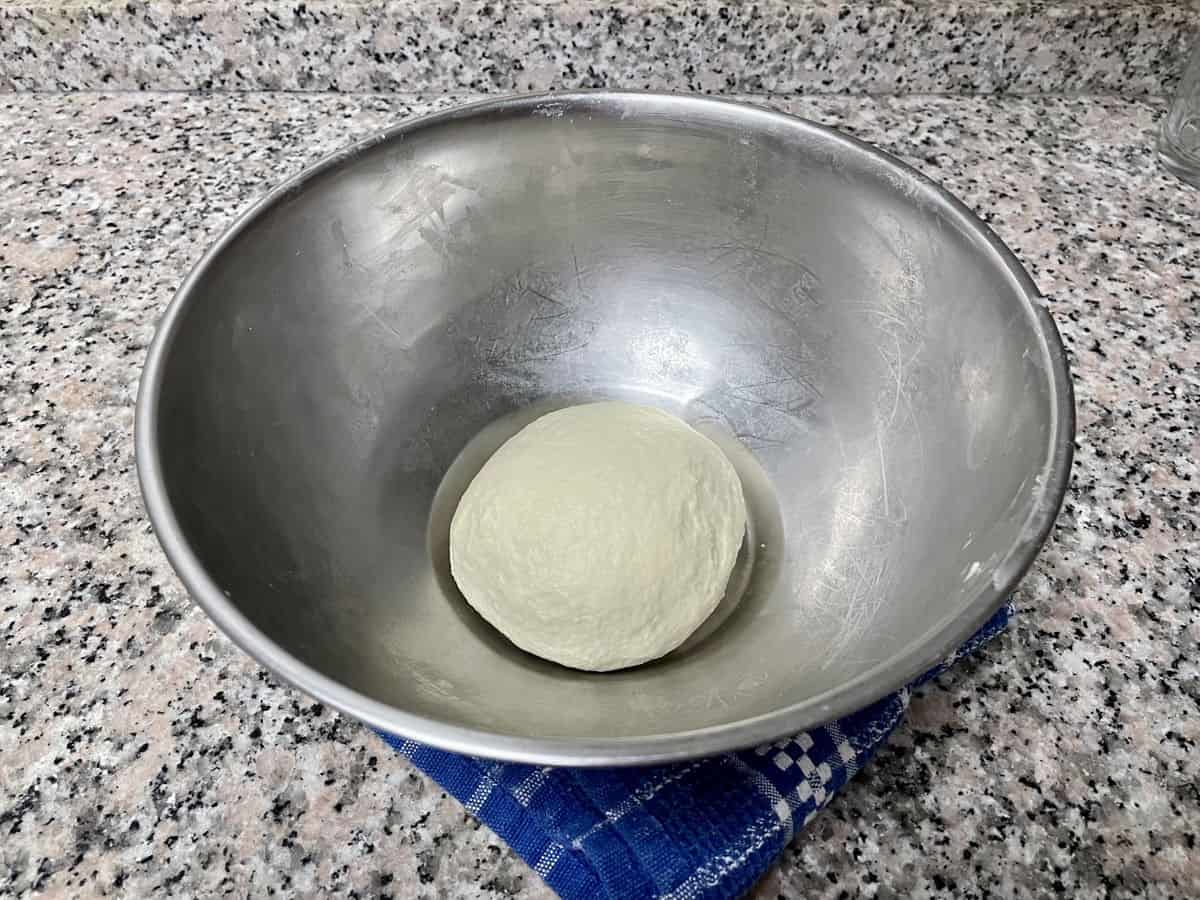
Add most of the water and use a rubber spatula to bring the flour together. This way, you can escape the messy fingers. Once the flour comes together, start kneading using your hands for 5 to 8 minutes.
If the dough comes together easily, it means you need to drizzle some more water into the dough and knead again. You can always add water and work it into the dough by kneading. It will take 8 to 10 minutes to hand-knead the dough to perfect consistency.
The dough is ready when it is no longer sticky. It should be soft to the touch and easily stretch when you hold it to hang. Make a smooth ball and keep it covered for an hour. The dough resting time is important so don’t skip this step.
Rolling and stuffing
time taken: approx 45 minutes

Dust the work surface lightly with some flour and dump the dough on it.
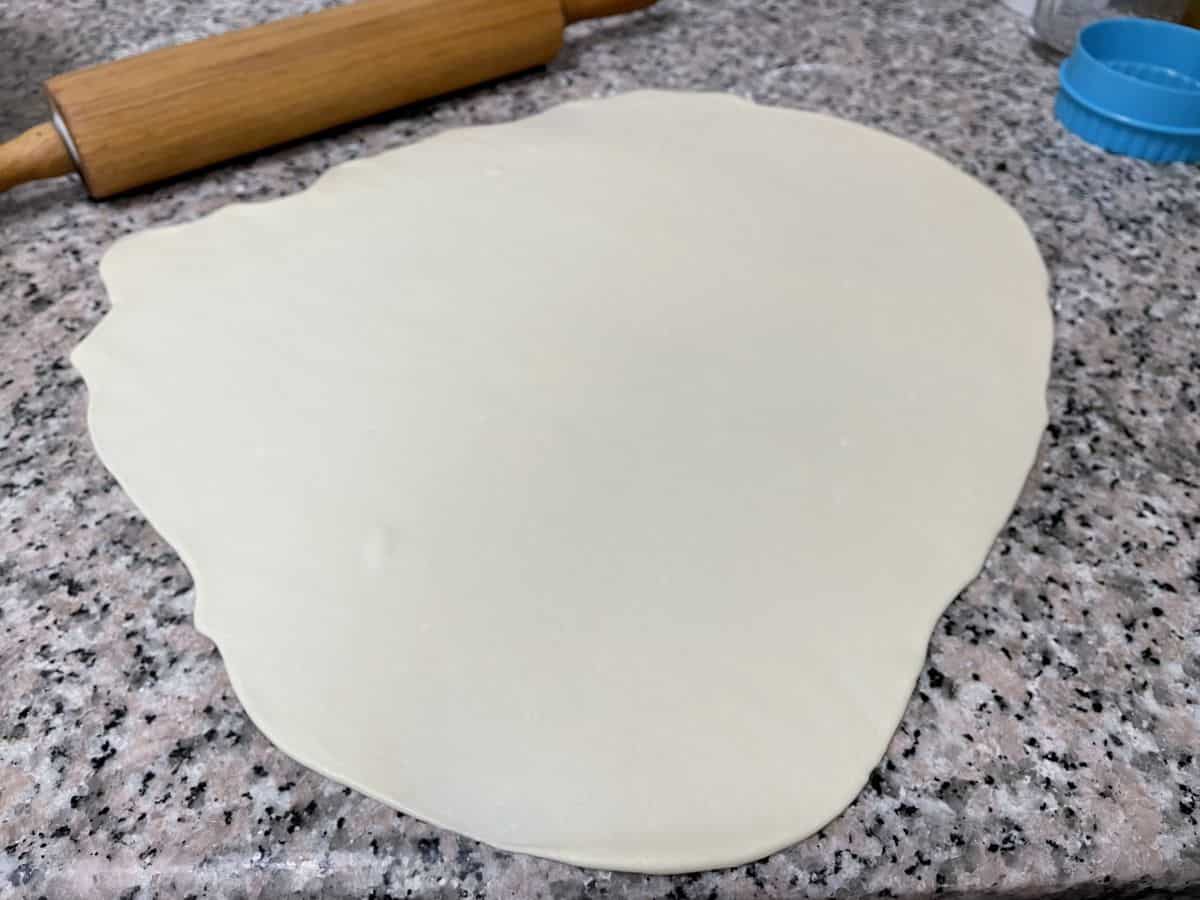
Use a rolling pin to flatten the pastry to at least ¼ inch thick. Roll from the centre to outward and repeat all sides for even thickness. The shape doesn't matter!
Hint: Don't add flour over the dough while rolling it out. This will cause the pastry to become dry and may open up while frying.
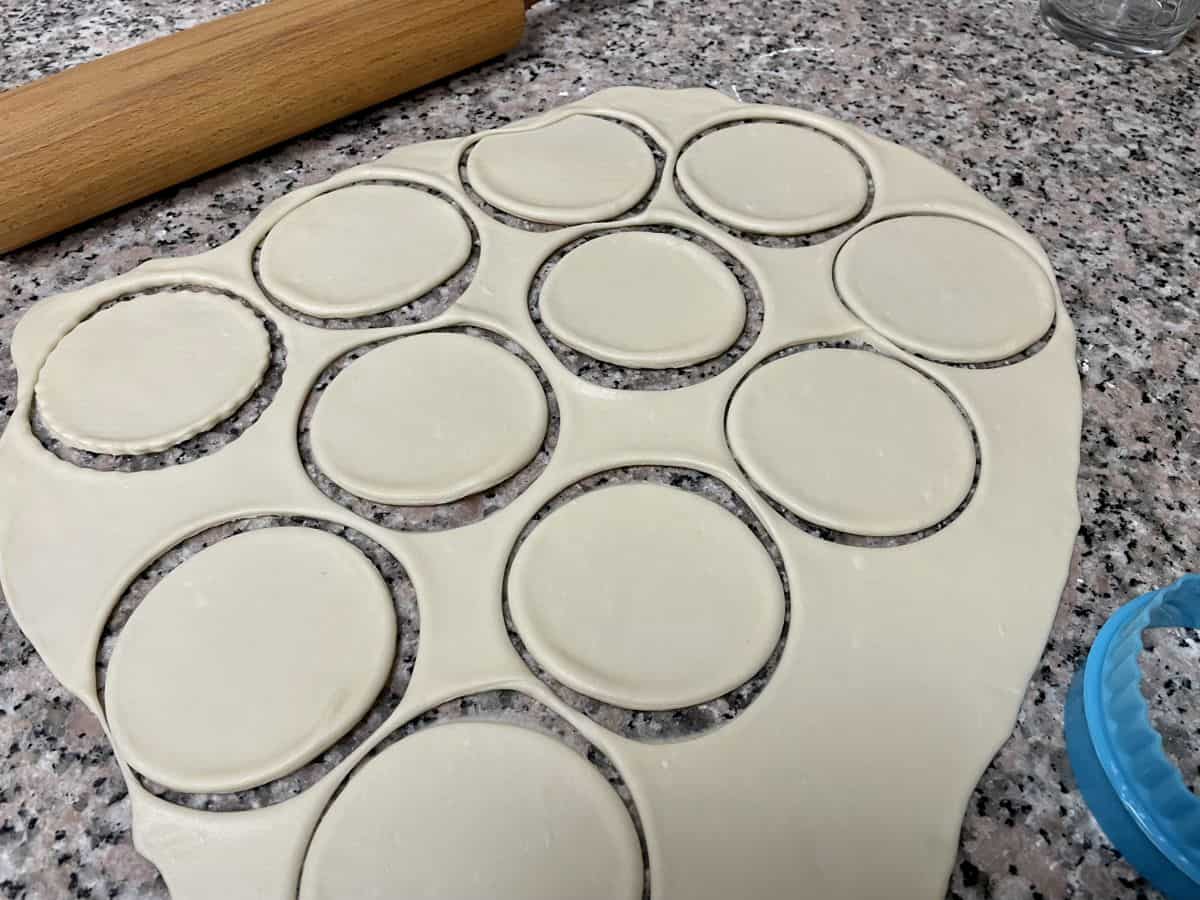
Use an 8 or 10-inch cookie cutter or any tumbler of similar size to cut out the circles. Aim from the edge to get maximum circles.
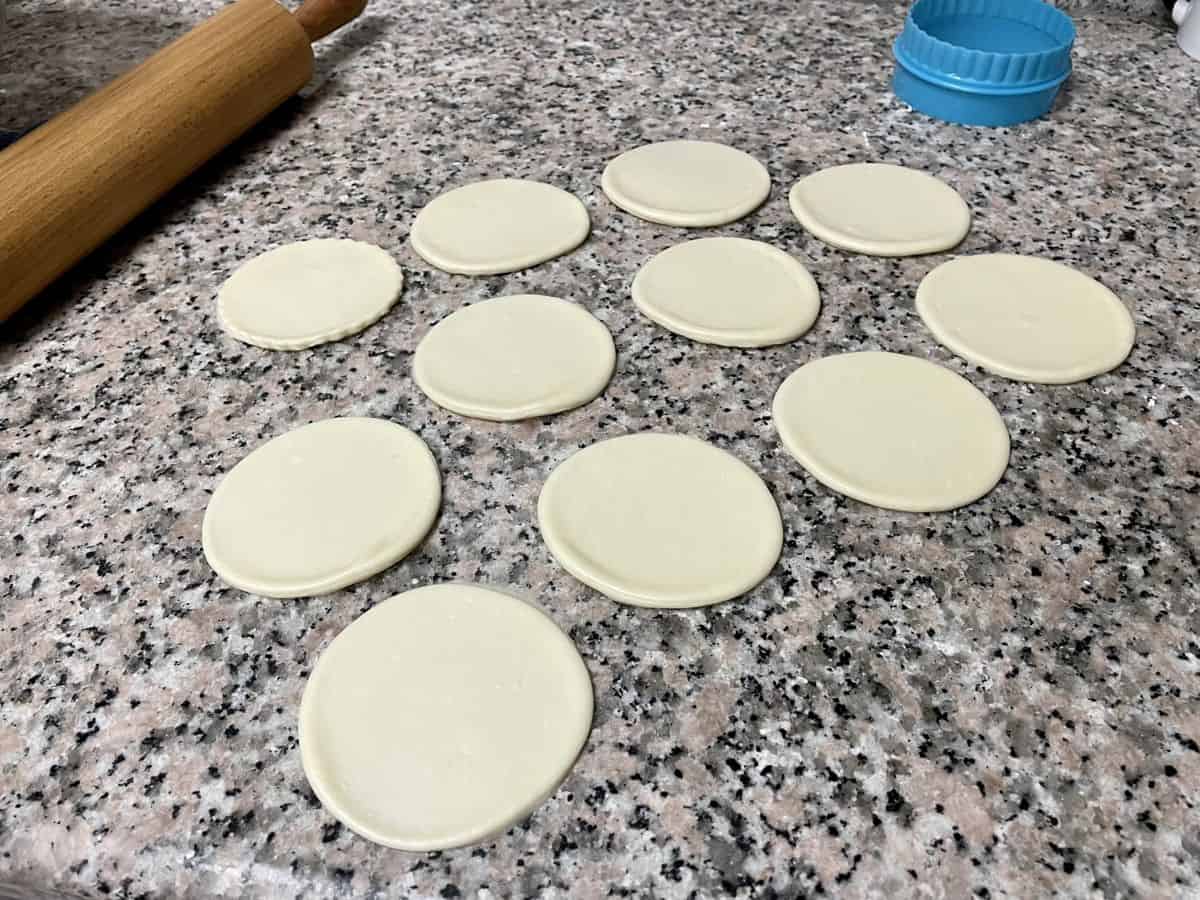
Remove the excess dough, make a smooth ball and keep it covered.
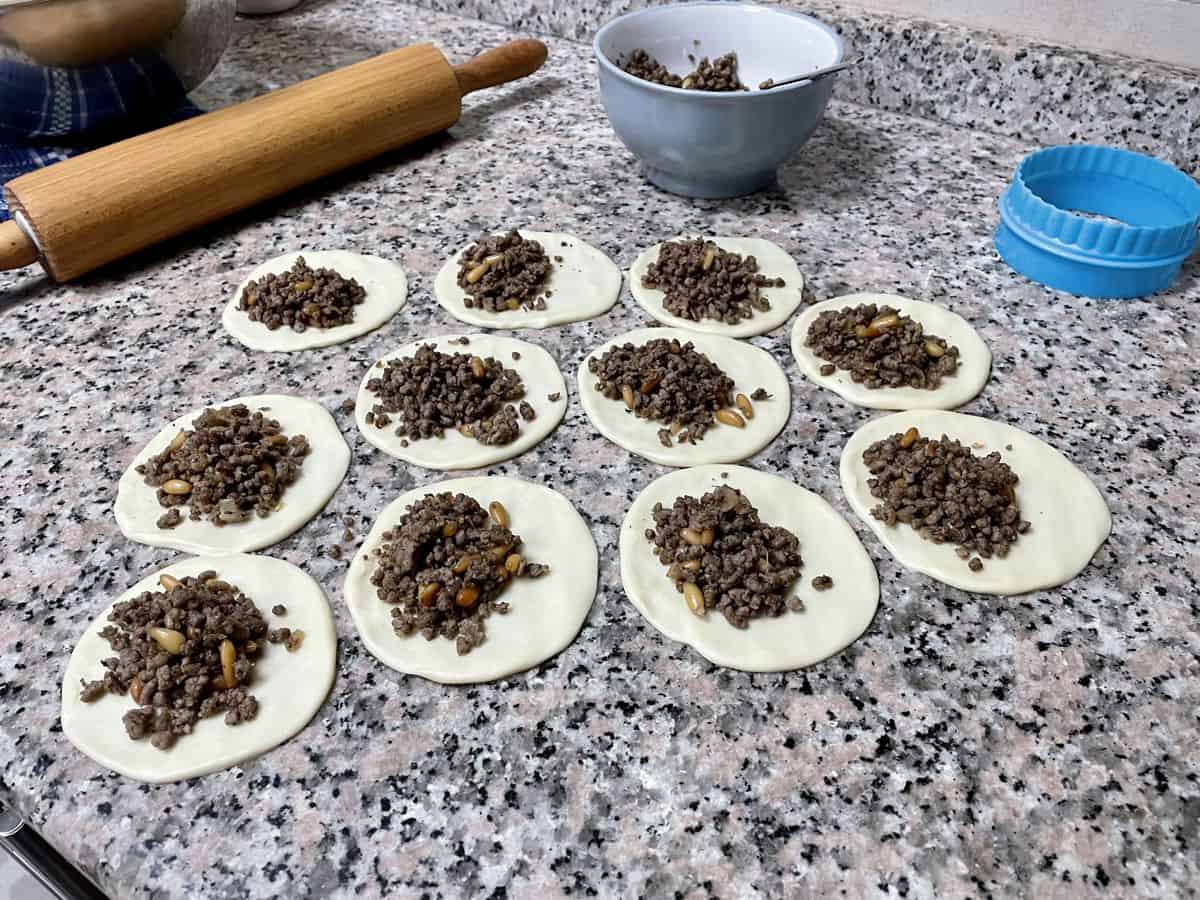
Place a teaspoon or two of the meat filling on one side of the circle leaving a margin space around the edge.
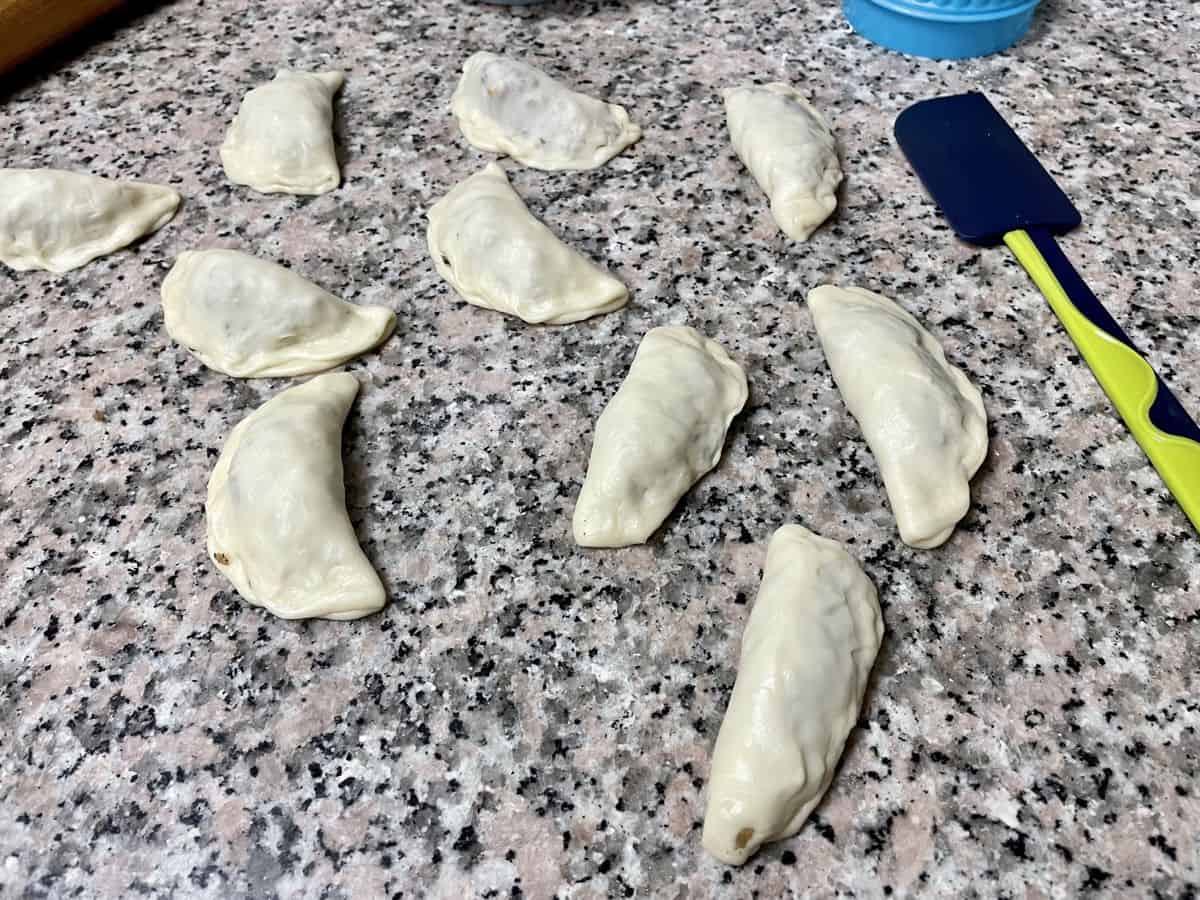
Bring the other half of the circle to form the half-moon shape and press along the sides to seal the pastries. Gently press the sambousek with your palm to release any trapped air. You can feel it when the air releases.
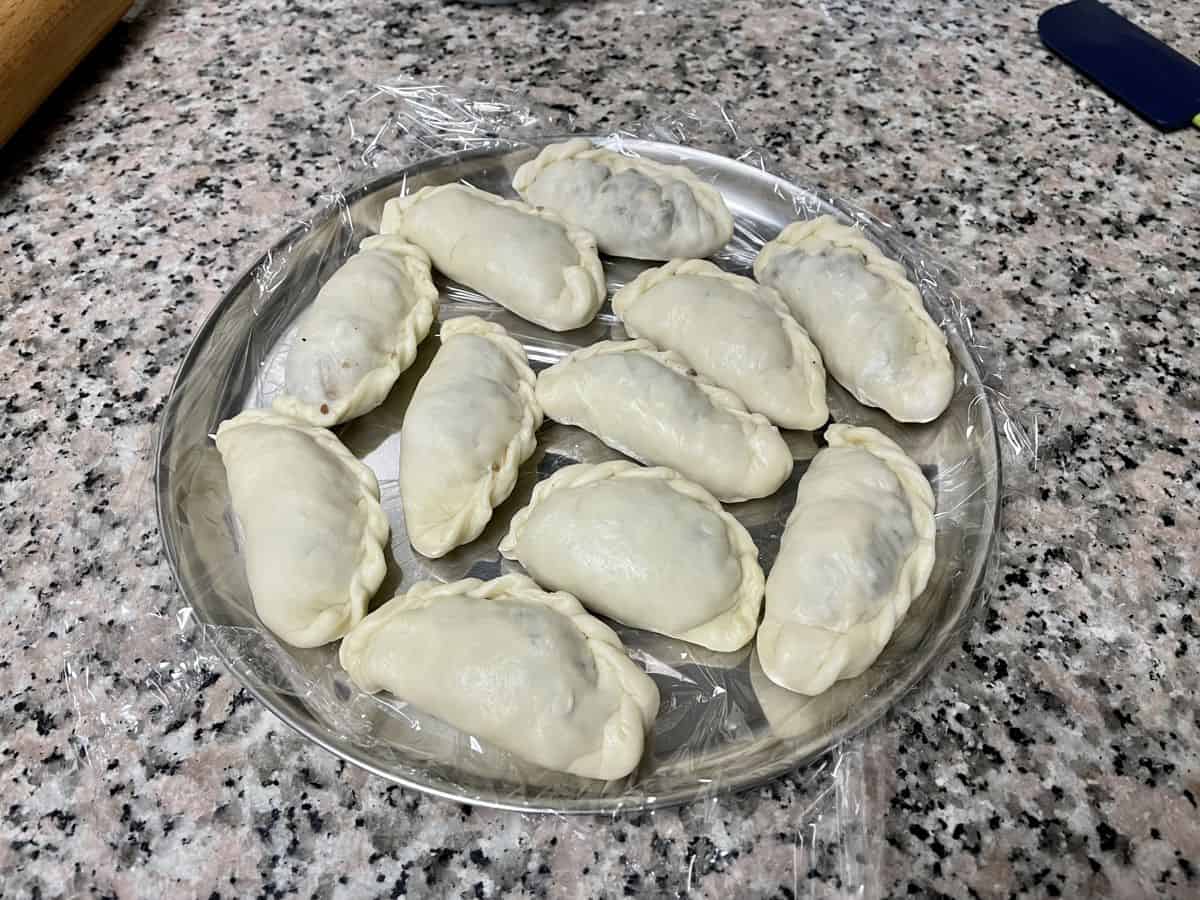
Then use a fork or hands to crimp the edges firmly to seal. Using your fingers, you can crimp the edge starting from one corner to create a patterned edge. Place the shaped sambouseks on cling film lined tray. Cover it with kitchen linen.
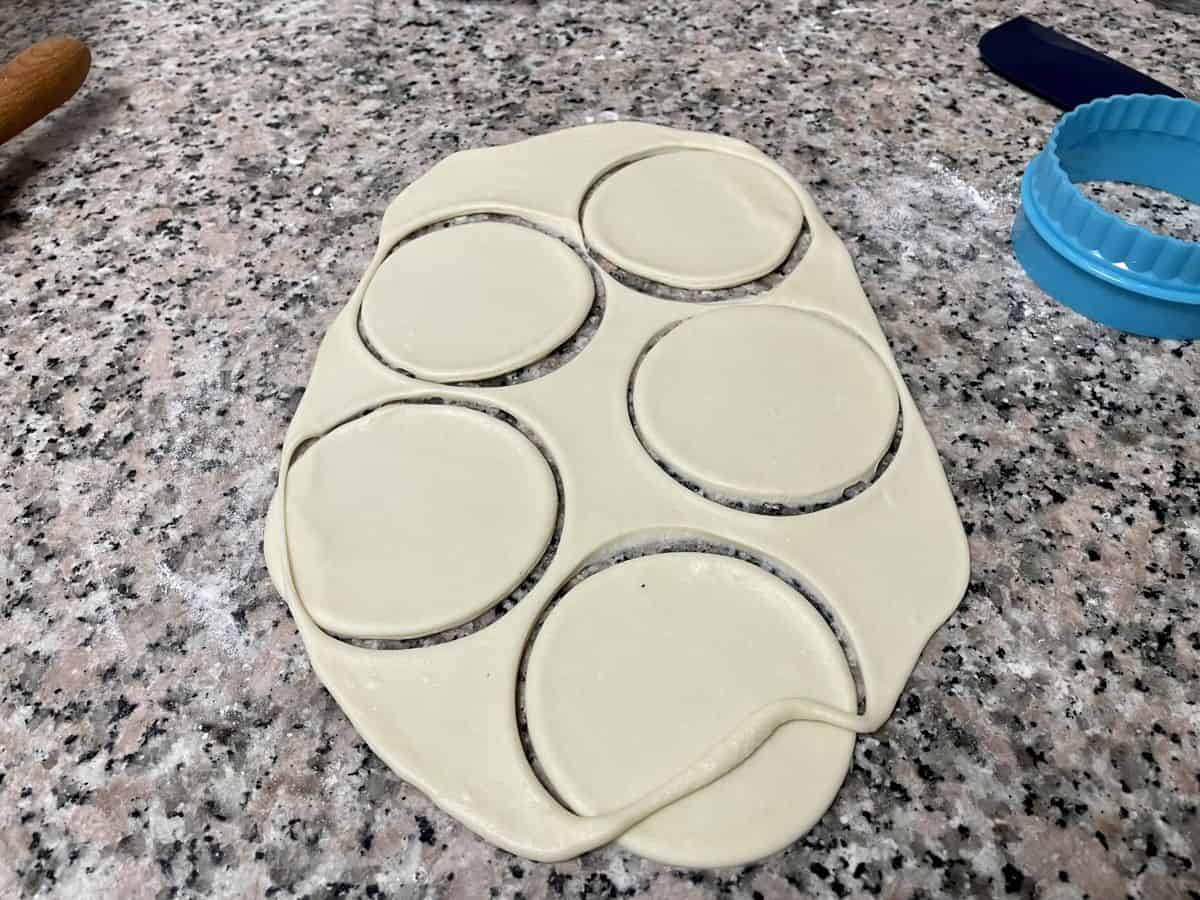
Continue with the remaining dough until you use up the filling. The size of the sambousek may differ based on the amount of filling and the size of the cookie cutter used.
Pro Tip: At this point, you can freeze the tray of sambouseks for 10 minutes so it is easy to fry. You may also keep them until frozen completely and put them in a freezer box or bag for later.
Frying sambousek
time taken: approx 25 minutes
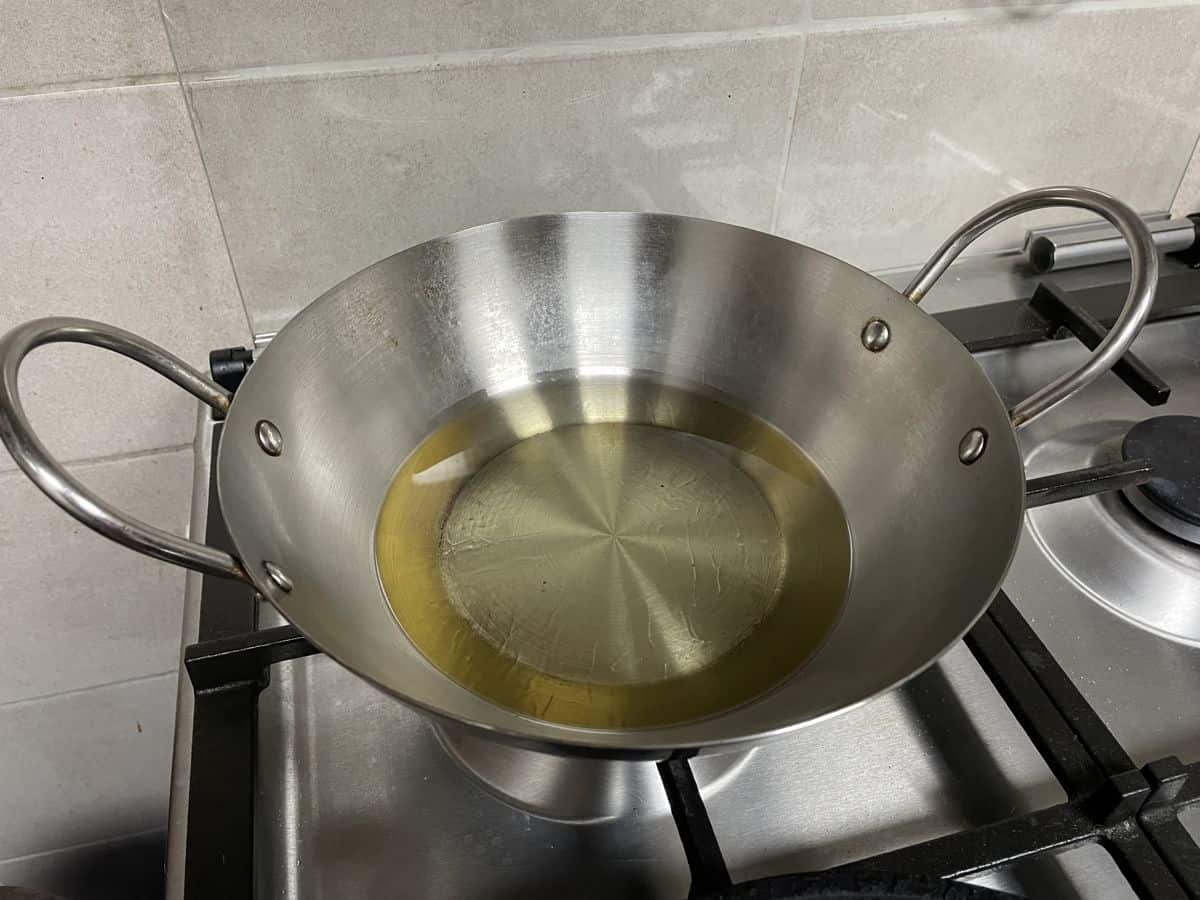
Heat enough cooking oil in a deep pan on medium to high heat. Place your palm over the pan to check if it is warm. Drop a tiny piece of dough into the oil, if it sizzles up quickly, then the oil is ready.
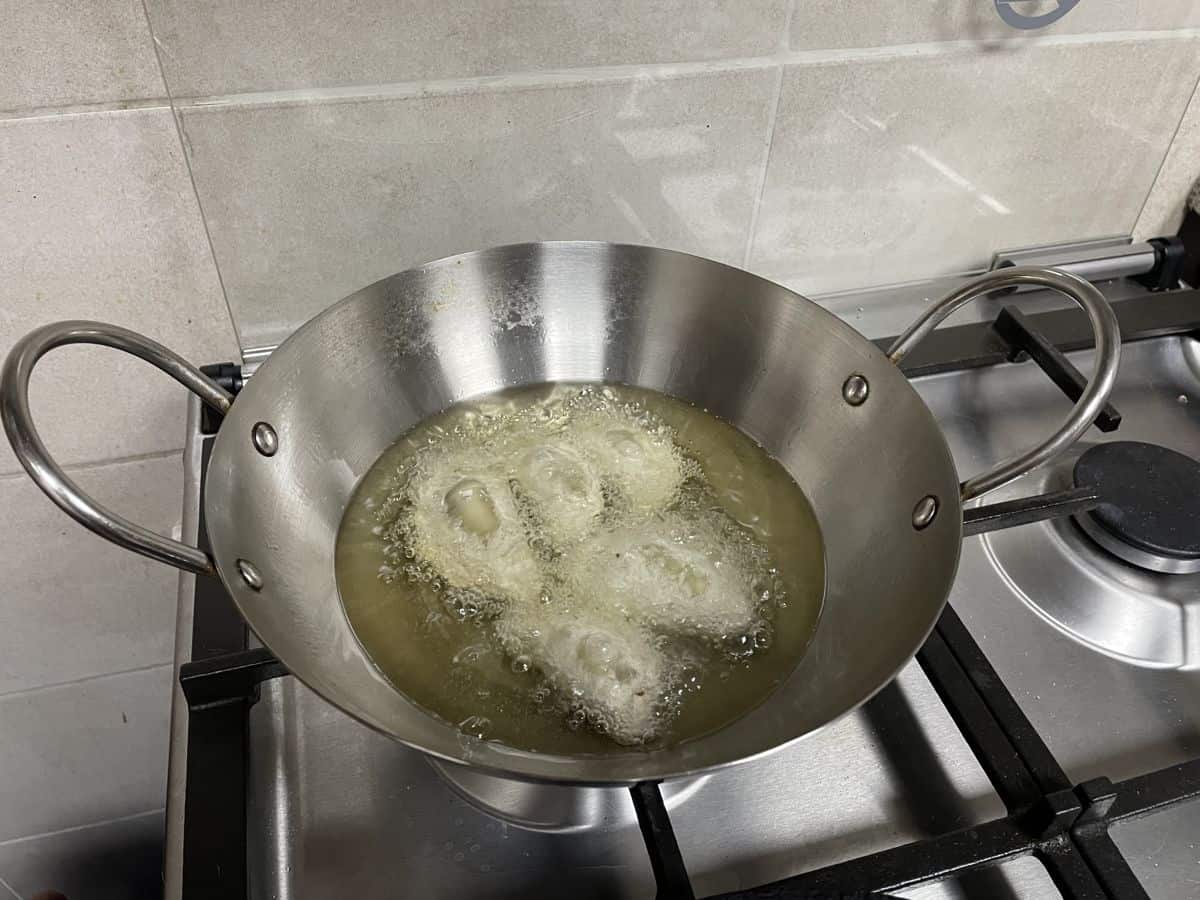
Add 3 to 5 Sambousaks and let them fry for around 45 seconds. If you notice the top is exposed without oil, use a spoon to ladle some oil over it before flipping them.
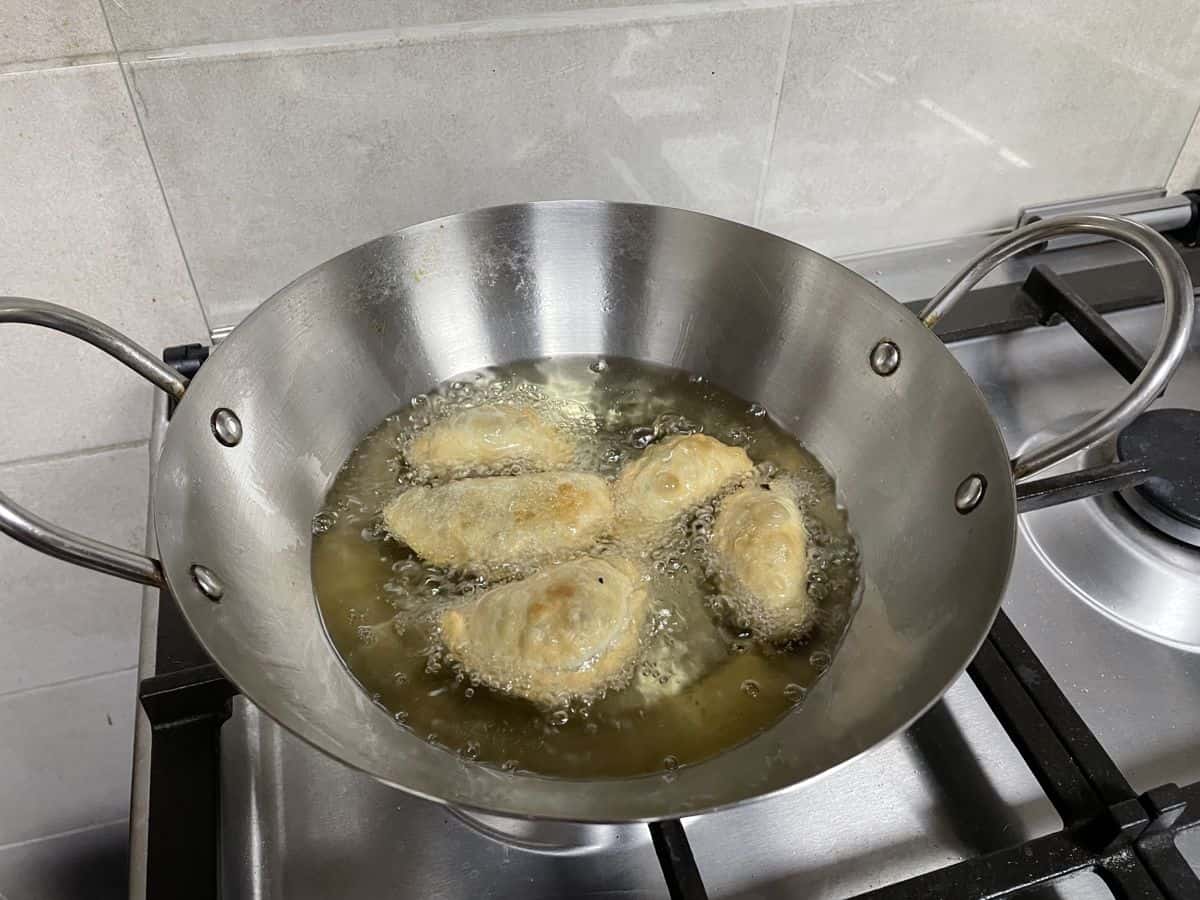
Fry the Sambousak for 4 to 6 minutes, turning them every minute or so until golden brown.
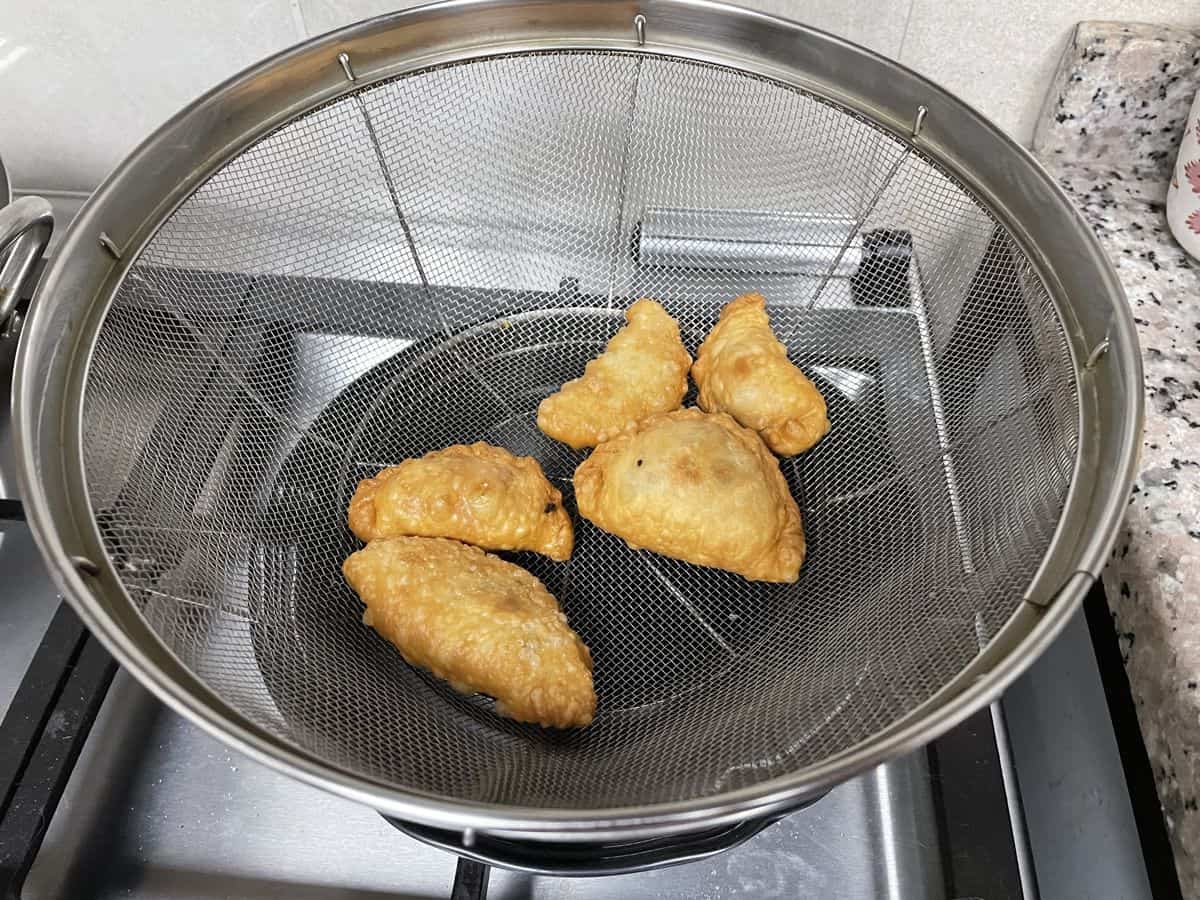
Remove from the oil and let them drain and dry in a mesh colander or wire rack. Serve warm

Troubleshooting
I have been trying to perfect this sambousak since past two Ramadan and the one issue I kept having was - the beef pastries open up while frying! I figured what causes them and tweaked the recipe to make it foolproof.
So, if you followed the recipe you shouldn't have this issue. Here are the possible reasons.
Issue: Opening up while frying:
- Dough rolled out too thin
- Dough too dry
- Sealed with crumbs in-between
- Oil not hot enough
Pastry not crispy when fried:
- Did not fry long enough
- Fried on high heat
Substitutions
- olive oil: I have used olive oil but you may use a mix of oil and melted butter or melted ghee.
- pine nuts: I know this is super expensive in India. You may replace this with lengthwise chopped almonds.
- ground beef: You may replace it with minced lamb or chicken.
- ground spices: I have used cinnamon and allspice but you can replace it with any Arabic spice mix you have in hand.
- pomegranate molasses: This is optional so you can skip this.
- fresh parsley: This is optional so you can skip this or use mint leaves.
- flour: I have used patent all-purpose flour. I have not tried with any other kind.
Variations
You can use this same dough recipe to make Sambousak Jibneh (cheese) or spinach sambouseks.
HINT: If you plan to serve variety of sambouseks, it would be a good idea to crimp using different methods to indicate different fillings.
Equipment
- a thick-bottomed skillet - to cook the meat filling
- a rolling pin
- an 8cm cookie cutter or tumbler
- a rubber spatula or bowl scrapper - to neatly remove the dough from the counter
- cling-wrap lined tray - to place and freeze
- A wide deep saucepot or kadai - to deep fry
- A slotted spoon - to remove fried sambousek
- A mesh strainer or wire rack - to drain the fried sambousek
Storage
Deep-fried meat sambouseks can be stored in a container for a day or two on the counter. You can refrigerate fried sambouseks for up to 5 days and use the oven to reheat them.
Unfried sambouseks can be frozen for up to a month and fried without thawing.
Top tip
Letting the fried sambouseks drain in a mesh colander or wire rack helps retain the crispness that can be lost if left on kitchen paper.
FAQ
Sambouseks are mini bite-sized crispy Arabic meat pies served as part of the mezze appetizer or snack. This Lebanese savoury pastry comes with a variety of fillings ranging from ground meat, shredded cheese, or spinach. They can be eaten on their own or with any dip that goes well with the filling used.
Going by the available records of history, fried filled-pastries called sanbusaj is mentioned in Annals of the Caliphs' Kitchens: Ibn Sayyar al-Warraq’s 10th century Baghdadi Cookbook. Samosa is mentioned in the cookbook Ni’matnama by Sultan Ghiyath Shahi of Central India written in the 15th century. It is believed Sambousek originated in Central Asia and travelled across west and east Asia taking on the local flavours and names.
You can reheat fried or baked sambousek in a few different ways. If it was made the same day and you want to warm it, then just place them on a hot pan and heat it turning a few times. If it was in the fridge, reheat it in the preheated oven at 120C for 6 to 8 minutes or until warm to heat. I don’t recommend using the microwave to reheat sambousek but if you need it quick and don’t mind the loss of crispiness, then go for it.
Place the sealed sambouseks on a lined tray and freeze until hard. Remove from the tray when frozen and transfer them to a box or Ziplock bag. Freeze for up to 2 months. To fry frozen sambouseks, remove them from the freezer and fry them in hot oil. Do not thaw frozen sambouseks.

📖 Recipe Card

Sambousek
Ingredients
For the meat filling
- 2 tablespoon olive oil
- 2 tablespoon pine nuts
- 1 large onion
- 250 grams ground beef
- ¼ teaspoon cinnamon powder
- ¼ teaspoon allspice powder
- 1 teaspoon pomegranate molasses
- 1 teaspoon freshly ground black pepper
- salt to taste
- fresh parsley, chopped (optional)
For the dough
- 1½ cups all-purpose flour
- ½ teaspoon salt
- 3 tablespoons olive oil
- ½ cup water
For frying
- cooking oil, to fry
Instructions
Meat filling
- Heat olive oil in a thick-bottomed skillet and fry the pine nuts until golden brown. Remove using a slotted spoon and keep them aside.2 tablespoon olive oil2 tablespoon pine nuts
- Add the finely chopped onion and saute for a few minutes until they start to brown.1 large onion
- Next, add ground meat – beef or lamb and fry along with the onions until every bit is browned. The meat will release moisture, so continue to fry until dry.250 grams ground beef
- Stir in the pomegranate molasses, ground spices, salt and pepper as per taste. Fry until mixed through and aromatic.¼ teaspoon cinnamon powder¼ teaspoon allspice powder1 teaspoon pomegranate molasses1 teaspoon freshly ground black peppersalt to taste
- Switch off and stir in the fried pine nuts and freshly chopped parsley if using. Transfer the content to a bowl and let it cool before using it.fresh parsley
Pastry dough
- Add the flour and salt to a large mixing bowl and stir it.1½ cups all-purpose flour½ teaspoon salt
- Drizzle the olive oil all over the flour. Take time to gradually rub the oil and flour between your palms until the flour resembles a grainy texture. When you grab some flour in your fist, it should hold shape but also break easily.3 tablespoons olive oil
- Add most of the water and use a rubber spatula to bring the flour together. This way, you can escape the messy fingers.½ cup water
- Once the flour comes together, start kneading using your hands. It will take 8 to 10 minutes to hand-knead the dough to perfect consistency. The dough is ready when it is no longer sticky. Make a smooth ball and keep it covered for an hour.
Shaping
- Line a tray with cling film or parchment paper and keep it aside.
- Dust the work surface lightly with some flour and dump the dough on it.
- Use a rolling pin to flatten the pastry to at least ¼ inch thick. Roll from the centre to outward and repeat all sides for even thickness.
- Use an 8 or 10-inch cookie cutter or any tumbler of similar size to cut out the circles. Aim from the edge to get maximum circles.
- Remove the excess dough, make a smooth ball, and keep it covered.
- Place a teaspoon or two of the meat filling on one side of each circle leaving a margin space around the edge.
- Before you fold over the other half, make sure there are no meat crumbs along the line. If the dough is stuck to the counter, use a bowl scraper or rubber spatula to gently release it.
- Bring the other half of the circle to form the half-moon shape and press along the sides to seal the pastries.
- Gently press the sambousek to release any trapped air. Then use a fork or hands to crimp the edges firmly to seal. Using your fingers, you can crimp the edge starting from one corner to create a patterned edge.
- Carefully remove the shaped sambouseks from the counter and place them on the lined tray. Cover it with kitchen linen. Continue with the remaining dough until you use up the filling.
Frying
- Heat enough cooking oil in a deep pan on medium to high heat. You need at least 2-inch deep oil so the sambouseks can be deep fried. Place your palm over the pan to check if it is warm. Drop a tiny piece of dough into the oil, if it sizzles up, then the oil is ready.cooking oil
- Add 3 to 5 Sambousaks and let them fry for around 45 seconds. If you notice the top is exposed without oil, use a spoon to ladle some oil over it before flipping them.
- Fry the Sambousak for 4 to 6 minutes, turning them every minute or so until golden brown on both sides.
- Remove from the oil and let them drain in a mesh colander or wire rack.
- Serve warm and store any remaining in a container.
Video
Notes
Nutrition Info
Good to read: Article by Sharmila Sinha about the History of Samosa.

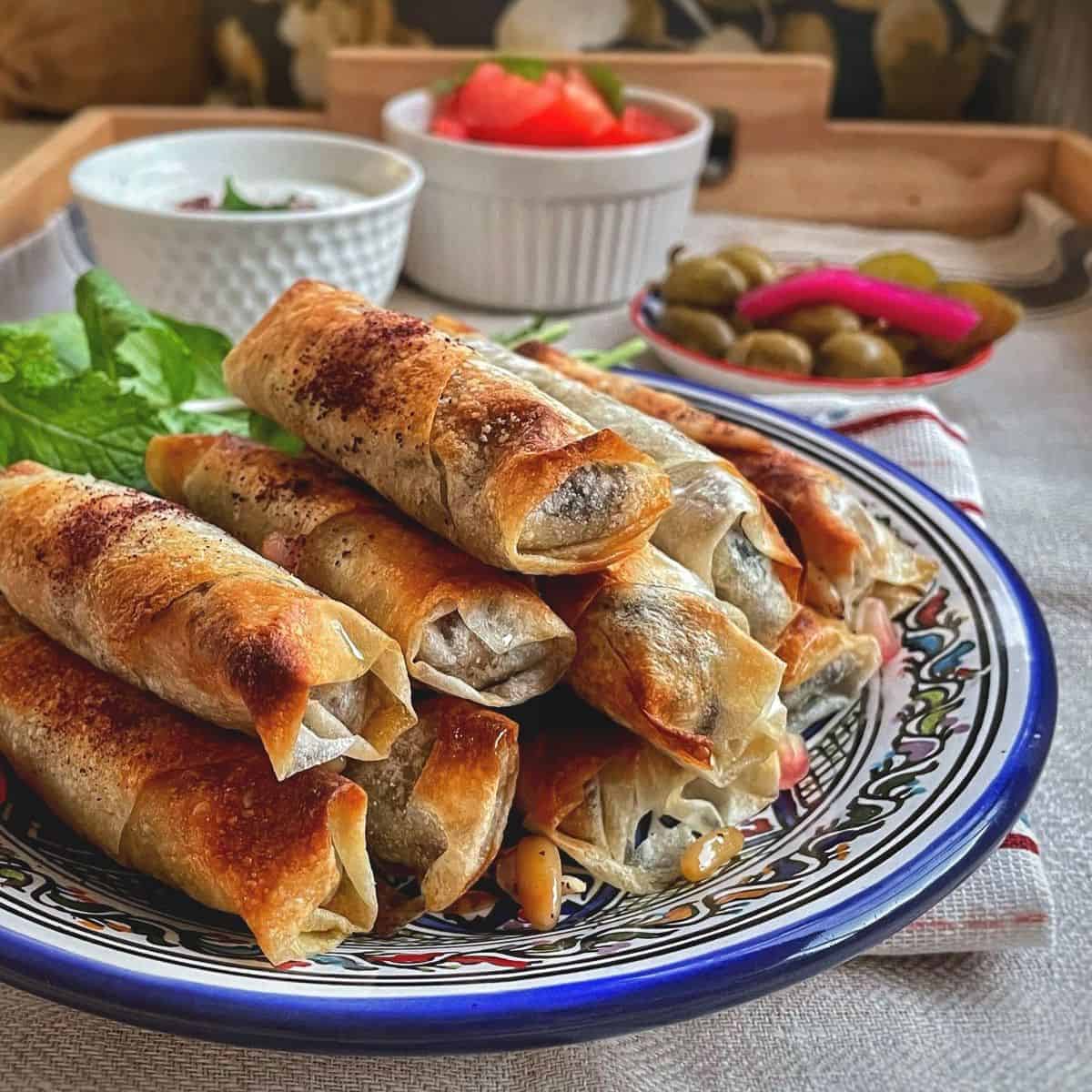

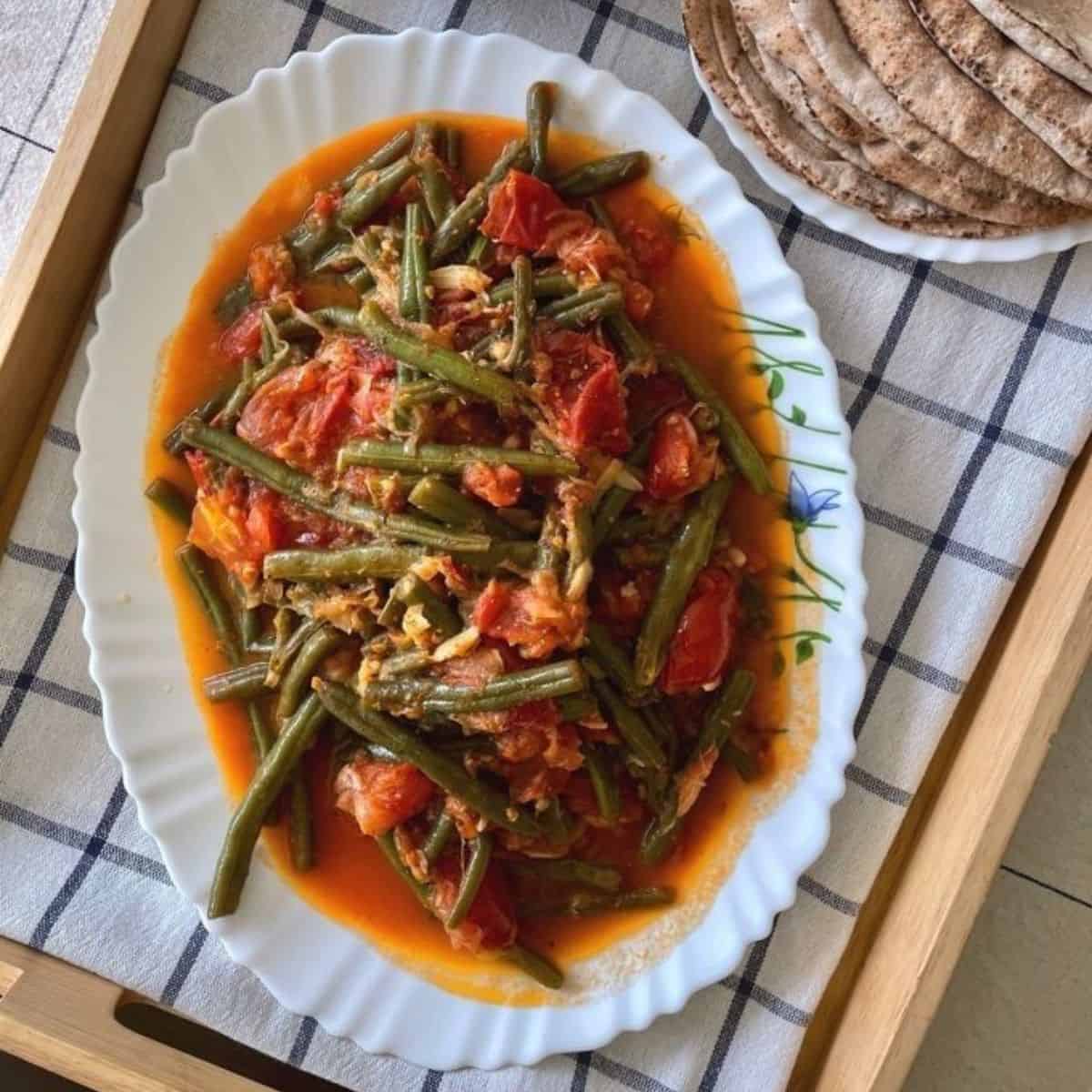
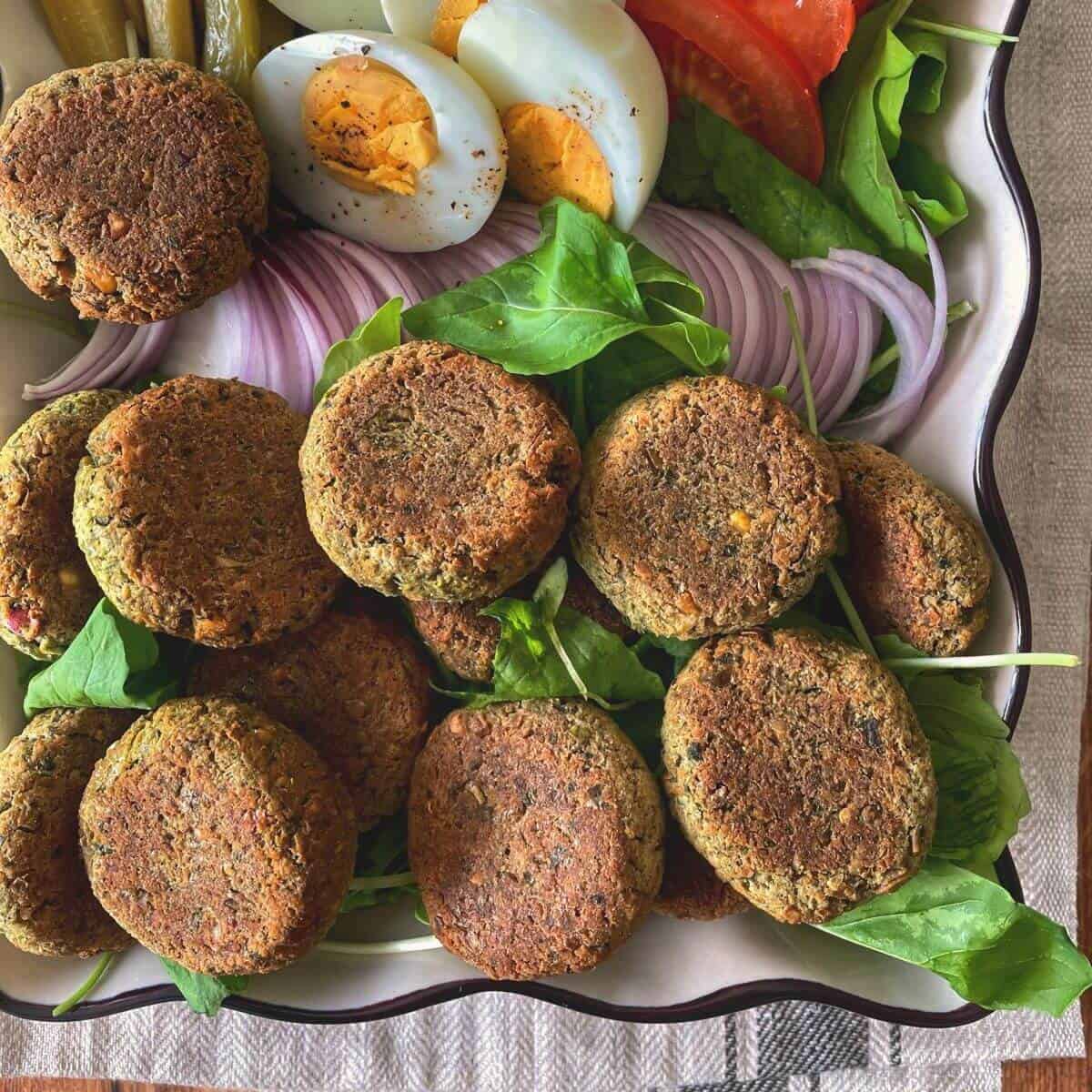
Hasmig says
Hello, I followed the recipe step by step but when I fried it my sambousek’s did not have the bubbles on the dough and the dough was not crunchy at all. Can you please help?
Famidha Ashraf says
Hi, I believe the olive oil in the dough that was rubbed to form coarse texture contributes to forming bubbles when fried in hot oil. If it is not cripsy, either the oil was not incorporated into the dough well enough or was the frying oil was not hot enough. When you add too many samobousek to fry, the oil temp goes down which in turn slows down th frying making the sambousek chewy? like instead of crispy. Hope this helps.